Exploring Fault Geometry and Holocene Deformation of the Littoral Fault Zone within the Seismic Gap South of Greater Bay Area, China
Abstract
:1. Introduction
2. Geological Setting
3. Data and Methods
3.1. Multichannel, Single-Channel Seismic Data
3.2. Chronology Data from the Borehole
3.3. The Expansion Index
4. Structural Architecture of the LFZ
4.1. Regional Structure of the LFZ in the Pearl River Estuary
4.2. Eastern Segment
4.3. Western Segment
5. Evolution of Fault Displacement over Time
6. Discussion
6.1. Structural Architecture of the LFZ
6.2. Holocene Deformation of the LFZ
6.3. Implications for Earthquake Hazard in Seismic Gap
7. Conclusions
Supplementary Materials
Author Contributions
Funding
Institutional Review Board Statement
Informed Consent Statement
Data Availability Statement
Acknowledgments
Conflicts of Interest
References
- Rocha, M.P.; de Azevedo, P.A.; Marotta, G.S.A.; Schimmel, M.; Fuck, R. Causes of Intraplate Seismicity in Central Brazil from Travel Time Seismic Tomography. Tectonophysics 2016, 680, 1–7. [Google Scholar] [CrossRef]
- Zoback, M.D. Climate and Intraplate Shocks Century of Phytoplankton Change. Nature 2010, 466, 568–569. [Google Scholar] [CrossRef] [PubMed]
- Cao, J.H.; Sun, J.L.; Xu, H.L.; Xia, S.H. Seismological Features of the Littoral Fault Zone in the Pearl River Estuary. Chin. J. Geophys. 2014, 57, 498–508. [Google Scholar] [CrossRef]
- Li, S.Z.; Suo, Y.H.; Liu, X.; Dai, L.M.; Yu, S.; Zhao, S.J.; Ma, Y.; Wang, X.F.; Cheng, S.X.; Xue, Y.C.; et al. Basic Structural Characteristics and Genetic Models of the South China Sea: Problems, Progress and Controversies. Mar. Geol. Quat. Geol. 2012, 32, 35–53. [Google Scholar] [CrossRef]
- Zhu, J.J.; Li, J.; Sun, Z.X.; Li, S.Z. Crustal Thinning and Extension in the Northwestern Continental Margin of the South China Sea. Geol. J. 2015, 51, 286–303. [Google Scholar] [CrossRef]
- Hui, G.G.; Li, S.Z.; Li, X.Y.; Guo, L.L.; Suo, Y.H.; Somerville, I.D.; Zhao, S.J.; Hu, M.Y.; Lan, H.Y.; Zhang, J. Temporal and Spatial Distribution of Cenozoic Igneous Rocks in the South China Sea and Its Adjacent Regions: Implications for Tectono-Magmatic Evolution. Geol. J. 2016, 51, 429–447. [Google Scholar] [CrossRef]
- Zhan, W.H.; Sun, Z.X.; Tang, C.; Zhu, J.J.; Sun, L.T. Littoral Active Fault Belt of South China and Its Control on Seismic Activity in Taiwan Strait. J. Trop. Oceanogr. 2004, 23, 19–24. [Google Scholar]
- Xu, H.L.; Qiu, X.L.; Zhao, M.H.; Sun, J.L.; Zhu, J.J. Characteristics of the Crustal Structure and Hypocentral Tectonics in the Epicentral Area of Nan’ao Earthquake (M7.5), the Northeastern South China Sea. Chin. Sci. Bull. 2006, 51, 95–106. [Google Scholar] [CrossRef]
- Xu, H.L.; Ye, C.M.; Qiu, X.L.; Sun, J.L.; Xia, S.H. Studies on the Binhai Fault Zone in the Northern South China Sea by the Deep Geophysical Exploration and Its Seismogenic Structure. South China J. Seismol. 2010, 30, 10–18. [Google Scholar] [CrossRef]
- Chen, D.Q.; Shao, Y.; Tan, Z.G.; Huan, Y.M. Spatial-Temporal Clustering Characteristics of M≥5 Moderate and Strong Seismic Activities in the Southeast Coastal Seismic Belt. South China J. Seismol. 2020, 40, 10–17. [Google Scholar] [CrossRef]
- Kagan, Y.Y.; Jackson, D.D. Seismic Gap Hypothesis: Ten Years After. J. Geophys. Res. 1991, 96, 21419–21431. [Google Scholar] [CrossRef]
- Liu, Y.X. The Active Fractures in South China Coast. Mar. Geol. Quat. Geol. 1985, 5, 11–21. [Google Scholar]
- Tan, M.T.; Qiu, Y.X.; Zou, H.P. Regional Tectonic Study in the Coastal of Guangdong. Geol. Miner. Explor. Bur. Guangzhou 2000, 45–71. [Google Scholar]
- Dong, H.G. The Basic Features of Shawan Fault and Analysis of the Coupling with the Landform. Geol. Miner. Resour. South China 2016, 32, 238–248. [Google Scholar] [CrossRef]
- Yu, Z.X.; Zhang, K.; Liang, H.; Li, Z.Y. Late Quaternary Tectonic Movements in the Pearl River Delta, China, Revealed from Stratigraphic Profiles. Trop. Geogr. 2016, 36, 334–342. [Google Scholar] [CrossRef]
- Zhao, M.H.; Qiu, X.L.; Ye, C.M.; Xia, K.Y.; Huang, C.L.; Xie, J.B.; Wang, P. Analysis on Deep Crustal Structure along the Onshore-Offshore Seismic Profile across the Binhai (Littoral) Fault Zone in Northeastern South China Sea. Acta Geophys. Sin. 2004, 47, 954–961. [Google Scholar] [CrossRef]
- Xia, S.H.; Zhao, M.H.; Qiu, X.L.; Xu, H.L.; Shi, X. Bin Crustal Structure in an Onshore-Offshore Transitional Zone near Hong Kong, Northern South China Sea. J. Asian Earth Sci. 2010, 37, 460–472. [Google Scholar] [CrossRef]
- Xia, S.H.; Qiu, X.L.; Tong, C.H.; Xu, H.L.; Zhao, M.H. Three-Dimensional Tomographic Model of the Crust beneath the Hong Kong Region. Geology 2012, 40, 59–62. [Google Scholar] [CrossRef]
- Cao, J.H.; Xia, S.H.; Sun, J.L.; Zhao, F.; Wan, K.Y.; Xu, H.L. Offshore Fault Geometrics in the Pearl River Estuary, Southeastern China: Evidence from Seismic Reflection Data. J. Ocean Univ. China 2018, 17, 799–810. [Google Scholar] [CrossRef]
- Xia, S.H.; Cao, J.H.; Sun, J.L.; Lv, J.S.; Xu, H.L.; Zhang, X.; Wan, K.Y.; Fan, C.Y.; Zhou, P.X. Seismogenic Structures of the 2006 ML4.0 Dangan Island Earthquake Offshore Hong Kong. J. Ocean Univ. China 2018, 17, 169–176. [Google Scholar] [CrossRef]
- Cheng, S.X.; Li, S.Z.; Suo, Y.H.; Liu, X.; Yu, S.; Dai, L.M.; Ma, Y.; Zhao, S.J.; Wang, X.F.; An, H.T.; et al. Cenozoic Tectonics and Dynamics of Basin Groups of the Northern South China Sea. Mar. Geol. Quat. Geol. 2012, 32, 79–93. [Google Scholar] [CrossRef]
- Suo, Y.H.; Li, S.Z.; Yu, S.; Somerville, I.D.; Liu, X.; Zhao, S.J.; Dai, L.M. Cenozoic Tectonic Jumping and Implications for Hydrocarbon Accumulation in Basins in the East Asia Continental Margin. J. Asian Earth Sci. 2014, 88, 28–40. [Google Scholar] [CrossRef]
- Zhang, Y.F.; Kuo-Chen, H.; Alvarez-Marron, J.; Brown, D.; Lin, A.T.S.; Xie, Z.Z.; Jin, X. Imaging Active Faulting in the Western Taiwan Strait. Sci. Rep. 2020, 10, 3703. [Google Scholar] [CrossRef] [PubMed]
- Hui, G.G.; Zhang, P.Z.; Li, Z.G.; Wang, W.T.; Hu, L.T.; Li, G.H.; Zhang, Y.P.; Sun, C.; Li, S.Z.; Liang, H.; et al. Opening of the South China Sea Marginal Basin: Insights from the Tectonic Evolution of the ENE-Striking Littoral Fault Zone. Mar. Pet. Geol. 2022, 145, 105854. [Google Scholar] [CrossRef]
- Sun, J.L.; Xu, H.L.; Zhan, W.H.; Cao, J.H. Activity and Triggering Mechanism of Seismic Belt along the Northern South China Sea Continental Margin. J. Trop. Oceanogr. 2012, 31, 40–47. [Google Scholar] [CrossRef]
- Cao, J.H.; Xia, S.H.; Sun, J.L.; Xu, H.L. Comparison of Fault Structure Characteristics in the Northern Pearl River Mouth Basin and Its Geological Implication. Prog. Geophys. 2014, 29, 2364–2369. [Google Scholar] [CrossRef]
- Hao, T.Y.; Liu, J.H.; Song, H.B.; Xu, Y. Geophysical Evidences of Some Important Faults in South China and Adjacent Marginal Seas Region. Prog. Geophys. 2002, 17, 13–23. [Google Scholar]
- Lee, C.M.; Workman, D.R. Earthquakes in the South China Region and Their Impact on Hong Kong. Seism. East. Asia Geol. Soc. Hong Kong Bull. 1996, 5, 92–103. [Google Scholar]
- Bureau, G.S. Earthquake Prevention and Disaster Reduction in 12th Five-Year Plan of Guangdong Province; Guangdong Seismological Bureau: Guangzhou, China, 2011. [Google Scholar]
- Pappin, J.W.; Koo, R.C.H.; Jiang, H.; Kwan, J.S.H.; Yu, Y.B.; So, M.M.L.; Shiu, Y.K.; Ho, K.K.S.; Pun, W.K. A Rigorous Probabilistic Seismic Hazard Model for Southeast China: A Case Study of Hong Kong. Bull. Earthq. Eng. 2015, 13, 3597–3623. [Google Scholar] [CrossRef]
- Chandler, A.M.; Mice, C. Review of Hong Kong Seismic Parameters and Determination of Design Level Earthquake Events. HKIE Trans. 2000, 7, 1–12. [Google Scholar] [CrossRef]
- Chau, K.T.; Wong, R.H.C.; Wong, Y.L.; Lai, K.W.; Chan, Y.W.; Wong, W.T.; Guo, Y.S.H.; Zhu, W. Three-Dimensional Surface Cracking and Faulting in Dangan Islands Area, South of Hong Kong. In Proceedings of the 3rd International Conference on Continental Earthquakes, Beijing, China, 8–11 August 2004; pp. 1–14. [Google Scholar]
- Zhang, Y.X.; Ye, X.W.; Wan, K.Y.; Lv, Z.Y.; Wen, G.G.; Xu, S.S. Fault Structure, Seismicity, and Magmatism of the Littoral Fault Zone, Northern South China Sea: Insights from High-Resolution Seismic Reflection Data. Mar. Pet. Geol. 2024, 160, 106605. [Google Scholar] [CrossRef]
- Lv, L.W.; Li, Z.G.; Wang, D.W.; Wang, W.T.; Dai, X.M.; Zeng, F.C.; Li, L.L.; Liang, H.; Hui, G.; Long, W.W.; et al. The Latest Activity of the Slope Fault Zone (Pearl River Mouth) in Northern South China Sea and Implications for Earthquake Hazard Assessments. Mar. Pet. Geol. 2024, 166, 106937. [Google Scholar] [CrossRef]
- Thorsen, C.E. Age of Growth Faulting in the Southern Louisiana. Trans. Gulf Coast Assoc. Geol. Soc. 1963, 13, 103–110. [Google Scholar]
- Groshong, R.H. 3-D Structural Geology: A Practical Guide to Quantitative Surface and Subsurface Map Interpretation; Springer: Berlin/Heidelberg, Germany, 2006; ISBN 9783540310549. [Google Scholar]
- Xiong, C.; Cao, J.H.; Sun, J.L.; Xia, S.; Wan, K.Y.; Fan, C.Y.; Yang, B. Variation Characteristics along the Strike of the Littoral Fault Zone in Offshore Pearl River Estuary. Earth Sci. 2018, 43, 3682–3697. [Google Scholar] [CrossRef]
- Xia, S.H.; Zhou, P.X.; Zhao, D.P.; Cao, J.H. Seismogenic Structure in the Source Zone of the 1918 M7.5 NanAo Earthquake in the Northern South China Sea. Phys. Earth Planet. Inter. 2020, 302, 106472. [Google Scholar] [CrossRef]
- Zhu, J.; Cai, F.; Xu, J.; Zhang, Y.B. Active Characters of Offset Structure in East Fujian Coast Area. J. Oceanogr. Taiwan Strait 2008, 27, 393–402. [Google Scholar]
- Yang, X.Q.; Heller, F.; Wu, N.Y.; Yang, J.; Su, Z.H. Geomagnetic Paleointensity Dating of South China Sea Sediments for the Last 130 Kyr. Earth Planet. Sci. Lett. 2009, 284, 258–266. [Google Scholar] [CrossRef]
- Wang, Q.Q.; Yang, X.Q.; Zhang, T. Quaternary Activity of Pearl River Estuary Segment of the Binhai Fault Zone. In Proceedings of the Annual Meeting of Chinese Geoscience Union (CGU), Taipei, Taiwan, 30 May–6 June 2021. [Google Scholar]
- Wang, Q.Q. Sedimentary Cycles and Environmental Evolution near Binhai Fault Zone since Middle Pleistocene. Master’s Thesis, Sun Yat-sen University, Guangzhou, China, 2022. [Google Scholar]
- Wells, D.L.; Coppersmith, K.J. New Empirical Relationships among Magnitude, Rupture Length, Rupture Width, Rupture Area, and Surface Displacement. Bull. Seismol. Soc. Am. 1994, 84, 974–1002. [Google Scholar] [CrossRef]
- Blaser, L.; Krüger, F.; Ohrnberger, M.; Scherbaum, F. Scaling Relations of Earthquake Source Parameter Estimates with Special Focus on Subduction Environment. Bull. Seismol. Soc. Am. 2010, 100, 2914–2926. [Google Scholar] [CrossRef]
- Okal, E.A.; Synolakis, C.E.; Kalligeris, N. Tsunami Simulations for Regional Sources in the South China and Adjoining Seas. Pure Appl. Geophys. 2011, 168, 1153–1173. [Google Scholar] [CrossRef]
- Ren, Y.F.; Wen, R.Z.; Zhang, P.; Yang, Z.B.; Pan, R.; Li, X.J. Implications of Local Sources to Probabilistic Tsunami Hazard Analysis in South Chinese Coastal Area. J. Earthq. Tsunami 2017, 11, 1740001. [Google Scholar] [CrossRef]
- An, C. Tsunamis and Tsunami Warning: Recent Progress and Future Prospects. Sci. China Earth Sci. 2021, 64, 191–204. [Google Scholar] [CrossRef]
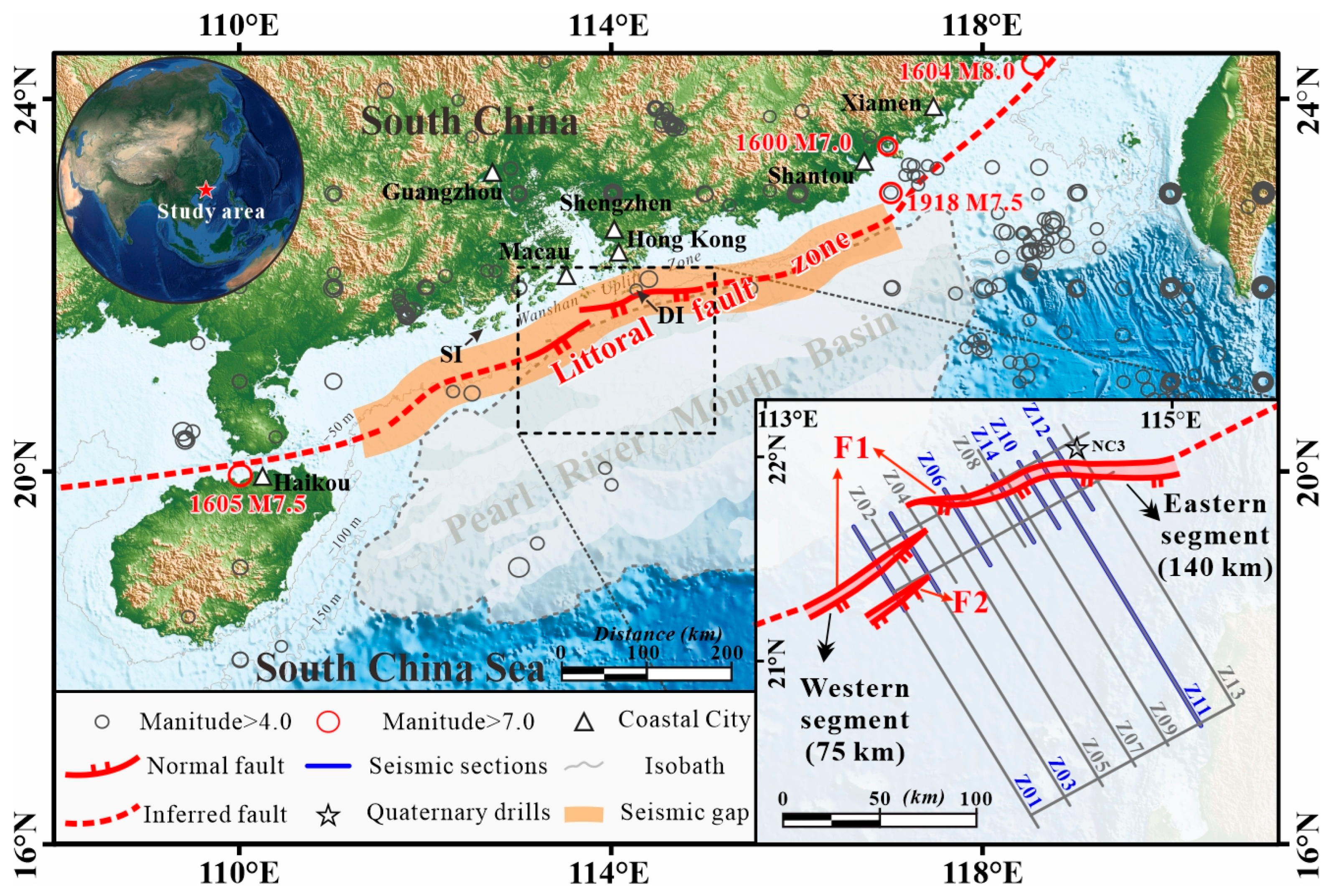


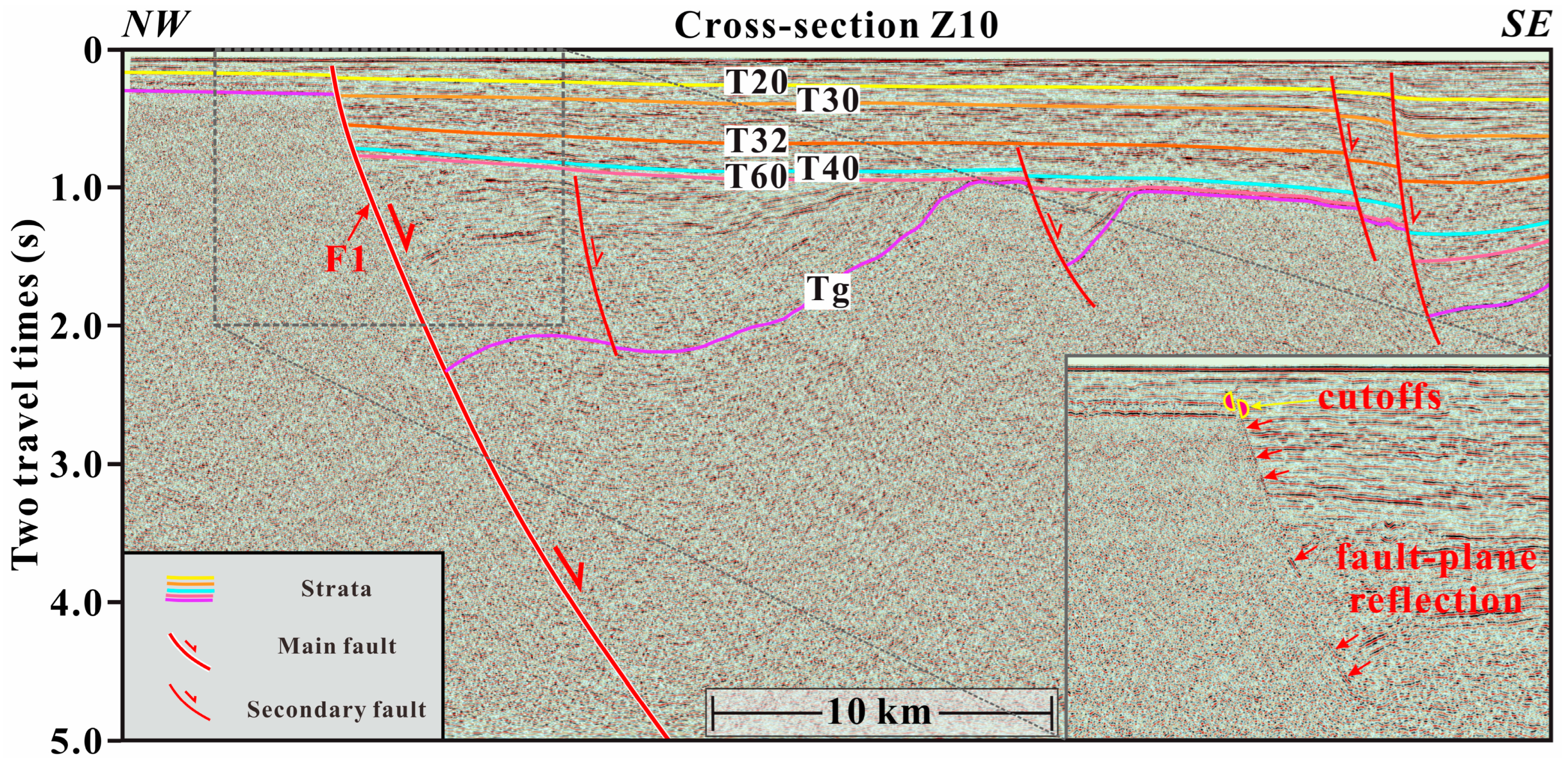
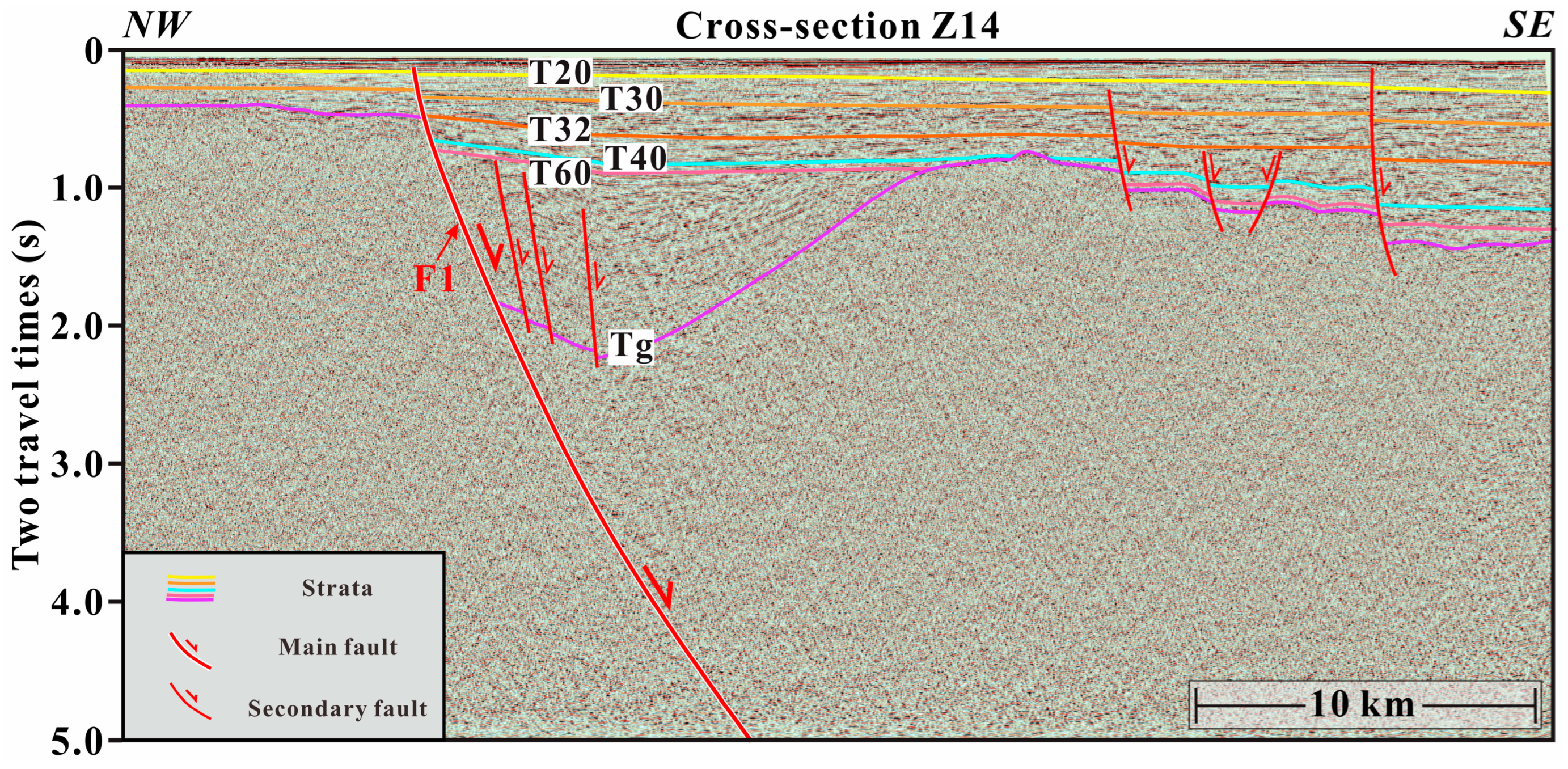

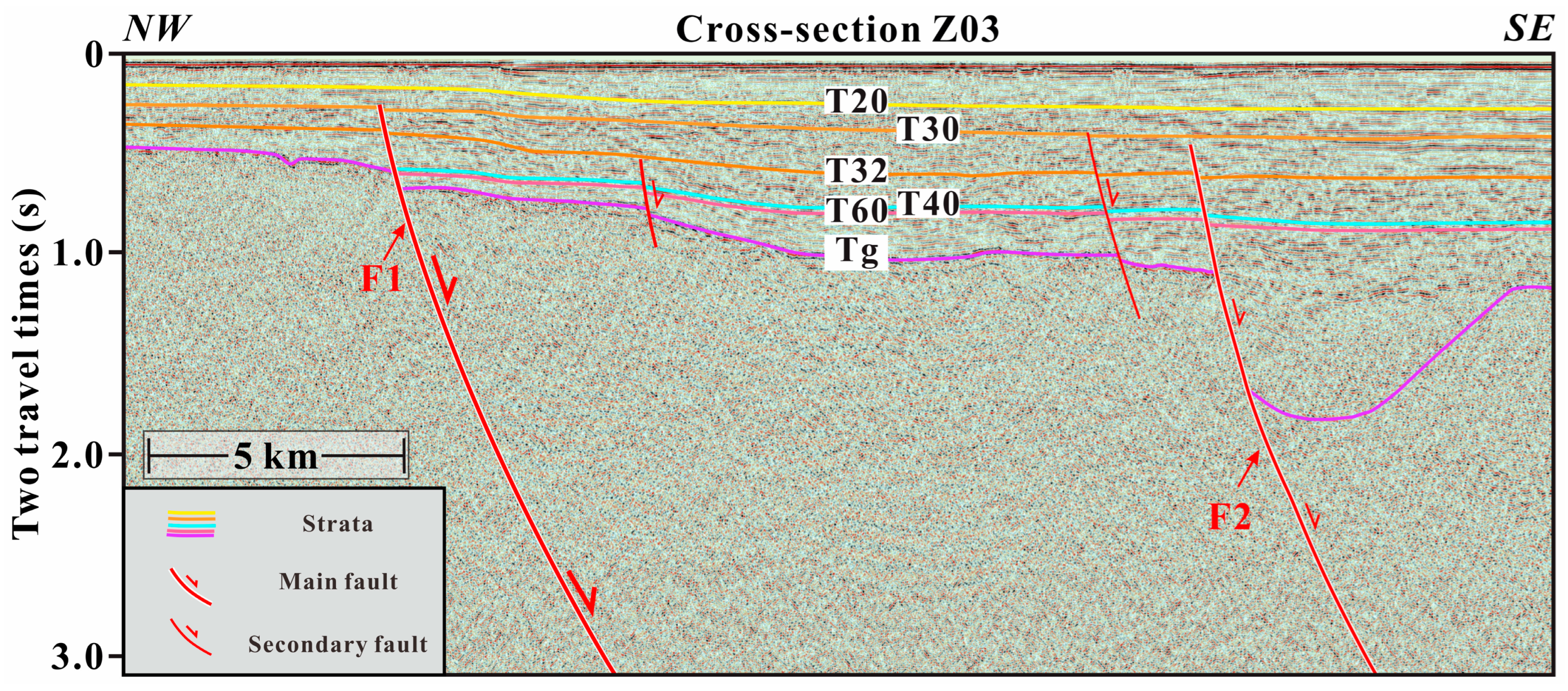


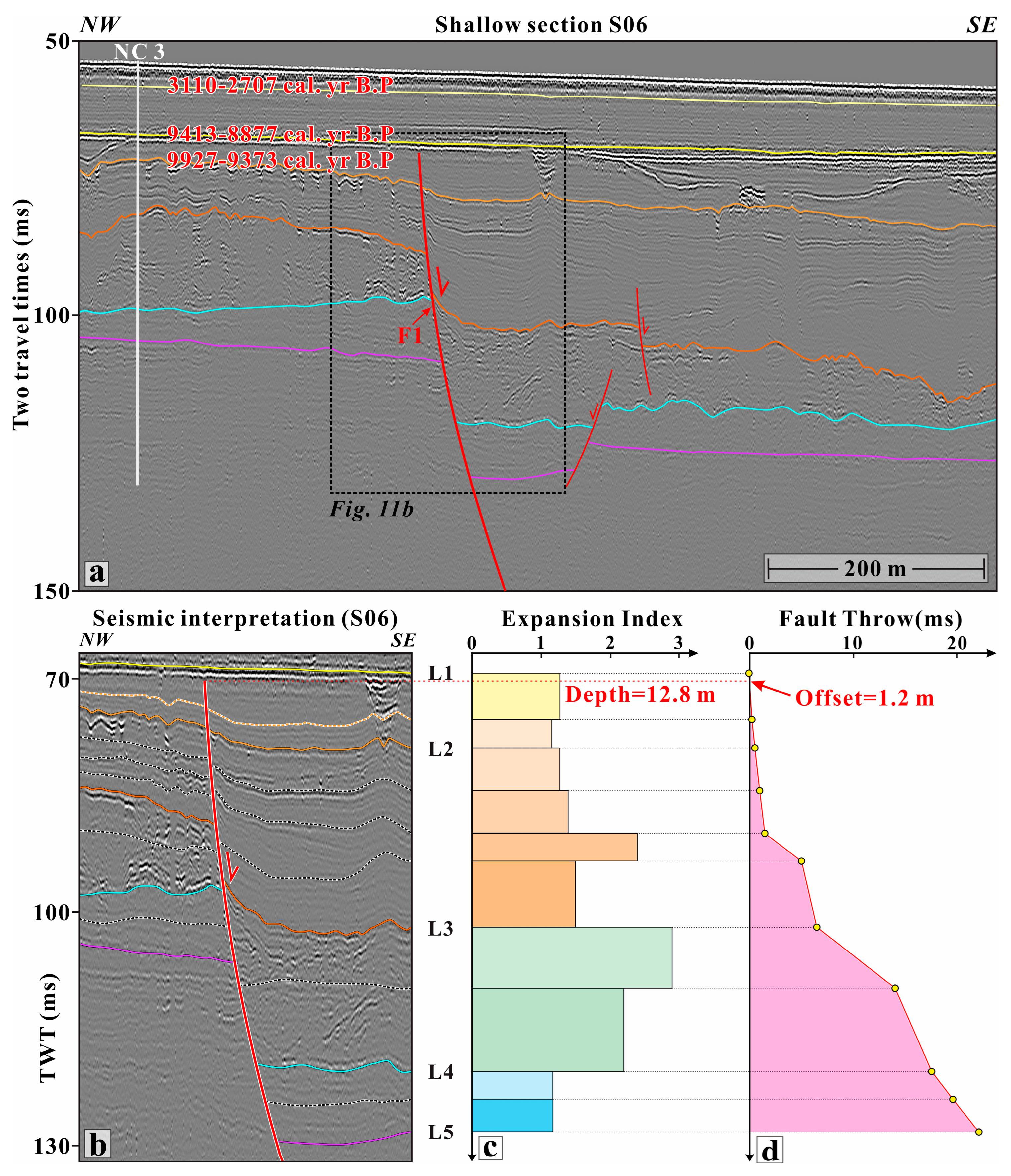
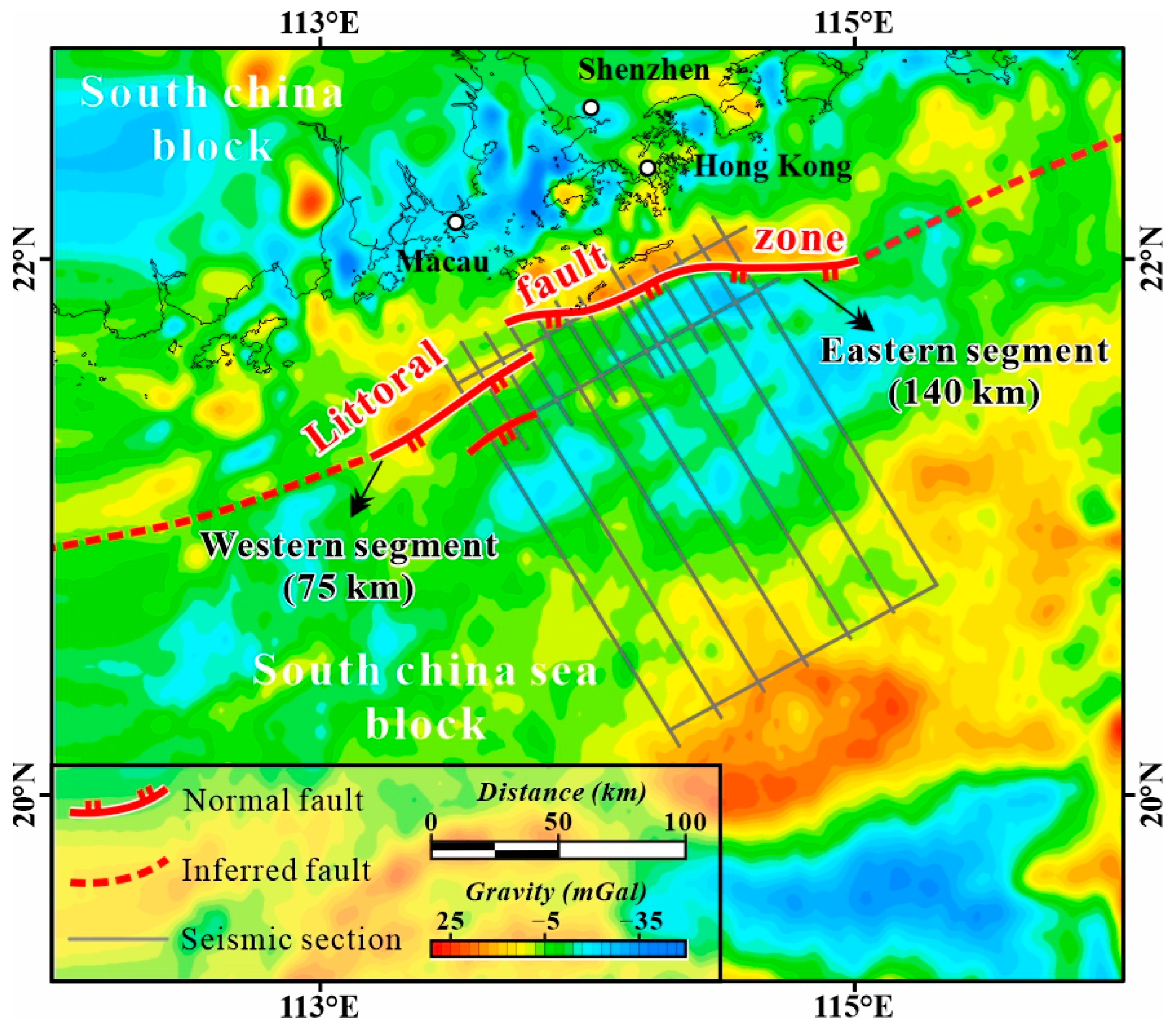
Disclaimer/Publisher’s Note: The statements, opinions and data contained in all publications are solely those of the individual author(s) and contributor(s) and not of MDPI and/or the editor(s). MDPI and/or the editor(s) disclaim responsibility for any injury to people or property resulting from any ideas, methods, instructions or products referred to in the content. |
© 2024 by the authors. Licensee MDPI, Basel, Switzerland. This article is an open access article distributed under the terms and conditions of the Creative Commons Attribution (CC BY) license (https://creativecommons.org/licenses/by/4.0/).
Share and Cite
Dai, X.; Li, Z.; Hu, L.; Zhang, P.; Yang, X.; Almeida, R.; Li, G. Exploring Fault Geometry and Holocene Deformation of the Littoral Fault Zone within the Seismic Gap South of Greater Bay Area, China. J. Mar. Sci. Eng. 2024, 12, 1350. https://doi.org/10.3390/jmse12081350
Dai X, Li Z, Hu L, Zhang P, Yang X, Almeida R, Li G. Exploring Fault Geometry and Holocene Deformation of the Littoral Fault Zone within the Seismic Gap South of Greater Bay Area, China. Journal of Marine Science and Engineering. 2024; 12(8):1350. https://doi.org/10.3390/jmse12081350
Chicago/Turabian StyleDai, Xiangming, Zhigang Li, Litian Hu, Peizhen Zhang, Xiaoqiang Yang, Rafael Almeida, and Guanhua Li. 2024. "Exploring Fault Geometry and Holocene Deformation of the Littoral Fault Zone within the Seismic Gap South of Greater Bay Area, China" Journal of Marine Science and Engineering 12, no. 8: 1350. https://doi.org/10.3390/jmse12081350






